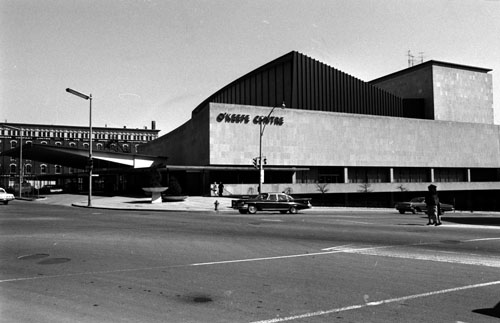This article is from our Toronto Feature series. Features from past programs are not updated.
This content is from a series created in partnership with Museum Services of the City of Toronto and Heritage Toronto. We gratefully acknowledge funding from the Ontario Ministry of Tourism, Culture and Sport, and the Department of Canadian Heritage.
"O'Keefe Centre Opens to Great Fanfare"
The O'Keefe Centre brought a new sophistication and glamour to Toronto's theatre-going experience. Architect Peter Dickinson created a cultural oasis in the city's downtown in his distinctive sculptural style. Dickinson's theatre features bold use of stone and metal and a daring canopy over the entrance lined with rows of mirrored globe lights. The O'Keefe, later called the Hummingbird Centre (1996) and then the Sony Centre (2007), was designed to present ballet, dance, Broadway musicals, opera and performers.
The centre opened to great fanfare in 1960, with the world premiere of Camelot, a musical starring Richard Burton, Julie Andrews and Robert Goulet. Others to appear there have included Harry Belafonte, Miles Davis, Rudolf Nureyev, Louis Armstrong, Jack Benny, Elton John and k.d. lang. Mikhail Baryshnikov defected after a performance there.
The beautiful interior features walls of white Carrara marble, cantilevered staircases of granite and bronze and cherry wood acoustic paneling. The focal point is a monumental 30-metre mural The Seven Lively Arts, by Toronto artist Ronald York Wilson.
In 2008, the Sony Centre closed for a redevelopment of the site, led by American architect, Daniel Libeskind. It re-opened on October 1, 2010--50 years to the day of its original opening. The new complex incorporates the theatre as well as a 57-storey residential space known as the "L Tower."

 Share on Facebook
Share on Facebook Share on X
Share on X Share by Email
Share by Email Share on Google Classroom
Share on Google Classroom





